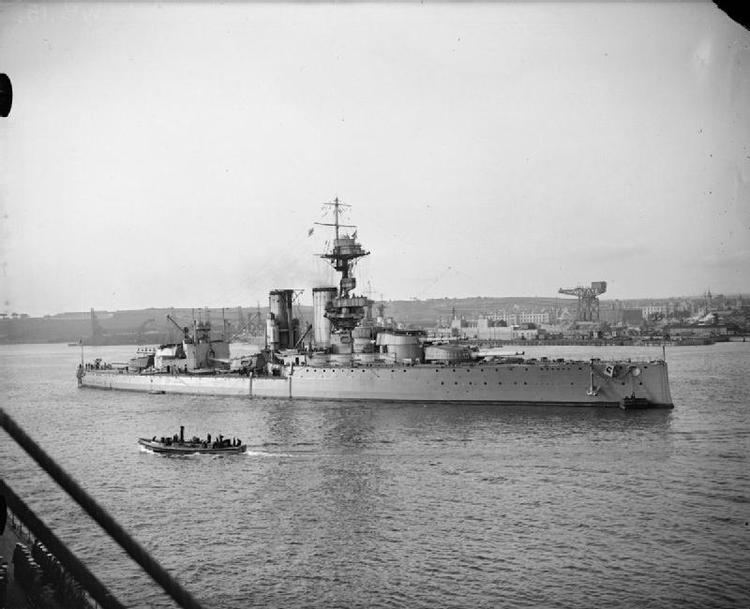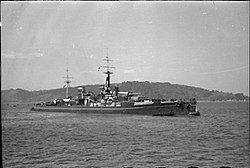Name Centurion Laid down 16 January 1911 Decommissioned 1924 Launched 18 November 1911 Beam 27 m | Commissioned May 1913 Construction started 16 January 1911 Length 182 m | |
 | ||
HMS Centurion was a battleship of the Royal Navy and the second of the King George V (I) class, built at HM Dockyard, Devonport. The King George V-class were a series of four super-dreadnoughts built just prior to and serving in the First World War. The King George V class immediately followed the Orion class upon which they were based. Her sister ships were: HMS King George V, HMS Audacious and HMS Ajax. In World War I she saw action in the Battle of Jutland and in 1919 she was involved in the Allied Intervention in the Russian Civil War. By World War II she had been decommissioned and was used as a Fleet tender and was eventually sunk as part of a temporary harbour built to support the Invasion of Normandy.
Contents

The Great War

Centurion was attached upon completion to the 2nd Battle Squadron, led by sister ship HMS King George V. She was present at the Battle of Jutland as part of the main body of the Grand Fleet under the command of Captain Michael Culme-Seymour. She was third in line in the First Division of the Fleet behind HMS King George V and HMS Ajax. Centurion was only lightly engaged at Jutland, firing four salvos of her main armament at the German Battlecruiser Lützow before HMS Orion blocked Centurion's line of fire. She took no hits.

After duty in the North Sea (where she was commanded for a time by Roger Keyes) she was sent to the Eastern Mediterranean in 1918 with HMS Superb to oversee the capitulation of the Ottoman Empire. In 1919, Centurion was dispatched to the Black Sea in the Allied Intervention in the Russian Civil War.
Interwar, World War II

With the signing of the Washington Naval Treaty Centurion was decommissioned and made a target ship to replace HMS Agamemnon in 1924. She remained in this role at Portsmouth Harbour until April 1941, where she was fitted with a false superstructure so as to resemble the battleship HMS Anson then building at HM Dockyard, Portsmouth.
On 4 April 1941, the Admiralty suggested that a heavy naval bombardment of the Libyan city of Tripoli should be made by the Mediterranean Fleet and followed up by blocking the port with a block ship, the Centurion. Admiral Andrew Cunningham declined the offer due to her slow speeds and heavy enemy air cover, so this idea was shelved.
In June 1942, she sailed with Operation Vigorous in the eastern Mediterranean to simulate an operational battleship. Between 1942 and 1944 Centurion was stationed off Suez as an anti-aircraft ship and to give pause to Regia Marina action in the area—the Italians thought that her false wooden 13.5-inch guns were real and kept their superdreadnoughts away. Her final act after a long and somewhat understated career was to be sunk as a breakwater off the Normandy beaches after D-Day. Reportedly the Germans thought that the old vessel had been sunk by shore batteries of the German 352nd Division with great loss of life when only 70 crewmen were observed leaving the sinking vessel; in fact the 70 men were the entire crew.
